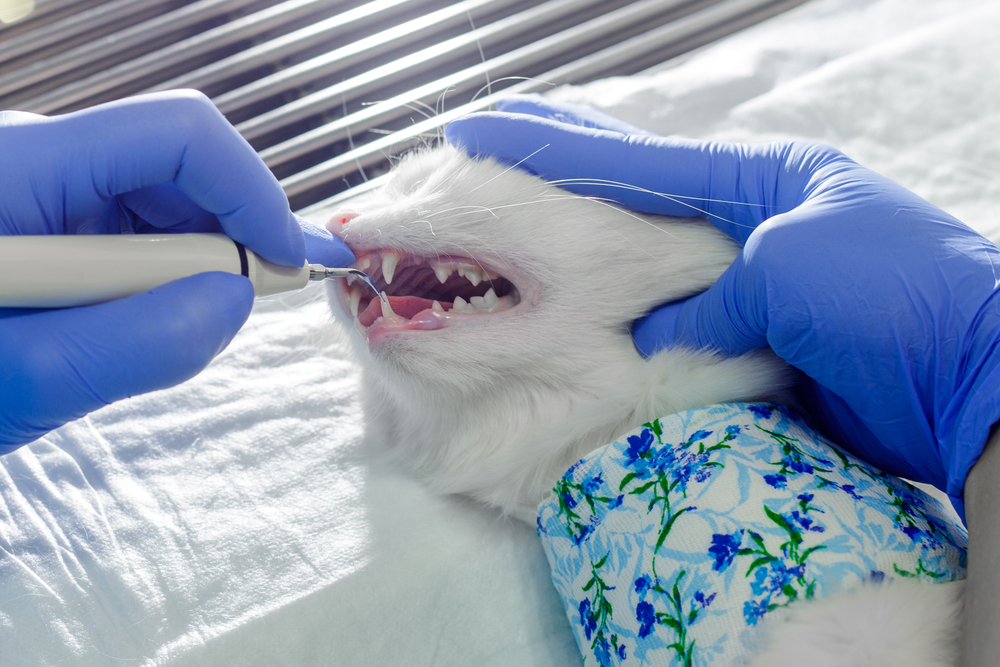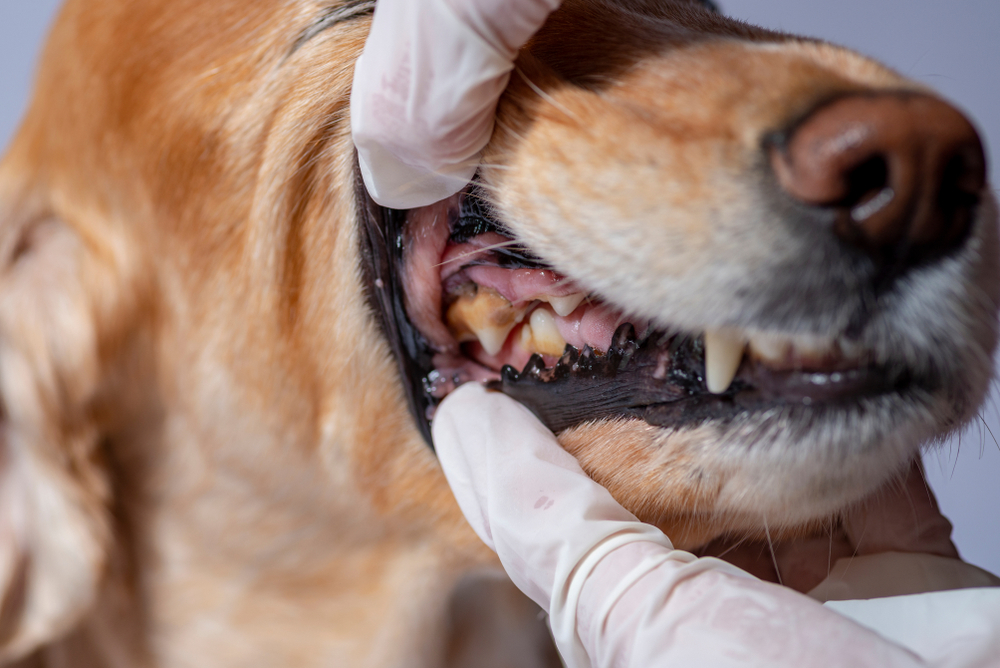Do your eyes water when you smell your pet’s breath? If so, they likely have dental disease. Studies have demonstrated that pets are extremely susceptible to dental disease, with 80% of dogs and 70% of cats having significant disease by the time they are 3 years of age. However, do not despair! Appropriate dental care can help prevent this damaging disease, and our Village Animal Hospital team is here to help with information about pet dental disease and protection for your four-legged friend.
Pet dental disease basics
Dental disease, also known as periodontal disease, is a progressive condition caused by damaging bacteria in your pet’s mouth. Important terminology to understand includes:
- Plaque — Plaque is a sticky film that forms on teeth, above and below the gum line, when bacteria in the mouth mix with food.
- Tartar —Mineral precipitates from saliva that deposit on your pet’s teeth must be removed in 24 to 75 hours before they cause the plaque to harden into calcified deposits called tartar.
Pet dental disease stages
Dental disease proceeds in the following stages:
- Stage 0 — When a pet’s mouth is healthy, the gingiva is pink and fully attached, and the mucosa is smooth and shiny.
- Stage 1 — Gingival inflammation (i.e., gingivitis) is the first stage of dental disease. The tissue is red and may bleed when your pet chews on food or toys.
- Stage 2 — The gingival tissue is swollen, and abnormal pockets may be present around the tooth. The ligament connecting the tooth to the jaw is inflamed, and less than 25% of bone is lost.
- Stage 3 — Moderately deep pockets form around the tooth, and 25% to 50% of the bony support is lost. Slight to moderate tooth mobility is present.
- Stage 4 — This stage involves severe inflammation, deep pocketing around the tooth, significant gingival recession, greater than 50% loss of bony support, and advanced tooth mobility.
Pet dental disease signs
Most pets with dental disease don’t exhibit signs. The condition is typically uncomfortable, and often painful, but pets are excellent at hiding vulnerabilities, making detection difficult. Signs you may notice when serious disease is present include:
- Halitosis — Bacteria in your pet’s mouth produce compounds with a foul odor.
- Bleeding, swollen gums — Gingival inflammation can cause the gums to swell and bleed.
- Difficulty eating — Your pet likely eats slowly or chews on only one side of their mouth.
- Behavioral changes — Your pet may avoid interaction or become more irritable.
- Nasal discharge — In some cases, dental disease can affect your pet’s nasal passages and sinuses, causing sneezing or a chronic nasal discharge.
- Ocular discharge — The upper tooth roots are close to the eyes and may cause ocular issues, resulting in a chronic eye discharge.
- Facial swelling — The infection may lead to significant tissue inflammation and cause facial swelling.
- Depression — In severe cases, bacteria can enter your pet’s bloodstream, damaging their organs, especially the heart, kidneys, and liver. If your pet has a systemic infection, they may act lethargic and depressed.
Pet dental disease prevention

The good news is that dental disease can be prevented with regular professional veterinary oral examinations and dental cleanings, which are the only way to remove bacteria from under your pet’s gum line, where most damage occurs. These procedures involve:
- Anesthetizing — Anesthesia is important to keep your pet still during the procedure and prevent unnecessary stress and fear.
- Scaling — We use an ultrasonic scaler to remove plaque and tartar above and below your pet’s gum line.
- Polishing — We smooth the enamel surface to help prevent future tartar buildup.
- Probing — After cleaning, we use a blunt dental probe to assess the gum tissue, find infection pockets below the gum line, and find issues such as exposed roots and crown fractures.
- Charting — We record all findings in your pet’s dental chart.
- Sealing — We apply a periodontal sealant to help fight bacteria for up to six months. This self-hardening liquid bandage device helps prevent plaque from attaching under or on the gingival margin.
- X-raying — Dental X-rays are necessary to identify problems in the tooth roots and the bones around the teeth.
- Treating — Antibiotic oral gels and sealants can reverse mild disease. We perform oral surgical procedures using nerve blocks, extraction techniques, bone grafting, gum tissue grafting, and successful pain management, for more advanced cases.
Pet dental disease prevention at home
Plaque forms only hours after a dental cleaning, so home dental care is important to prevent dental disease. Recommendations include:
- Brushing your pet’s teeth — Daily toothbrushing is the best way to remove plaque from your pet’s teeth. Start by getting your pet used to their mouth being handled, and gradually introduce a tooth brush and pet-friendly toothpaste. Find a flavor your pet enjoys to ease the process, and ensure you offer plenty of praise and treats when they cooperate.
- Providing dental treats — Chewing can help remove plaque and tartar from your pet’s teeth. Choose treats approved by the Veterinary Oral Health Council, and do not allow your pet to chew on excessively hard objects, such as antlers, bones, and hooves, that may damage their mouth.
Providing the appropriate dental care can protect your pet from dental disease. If you would like to schedule a professional veterinary dental cleaning, contact our American Animal Hospital Association (AAHA)-accredited team at Village Animal Hospital, so we can help ensure your pet’s mouth is healthy and pain-free.








Leave A Comment